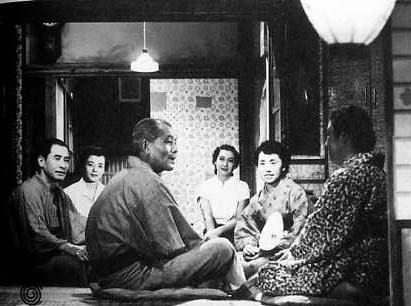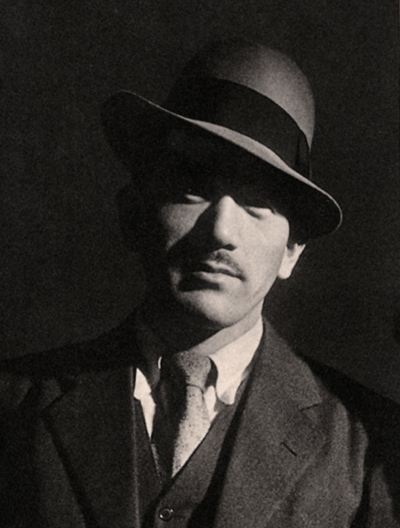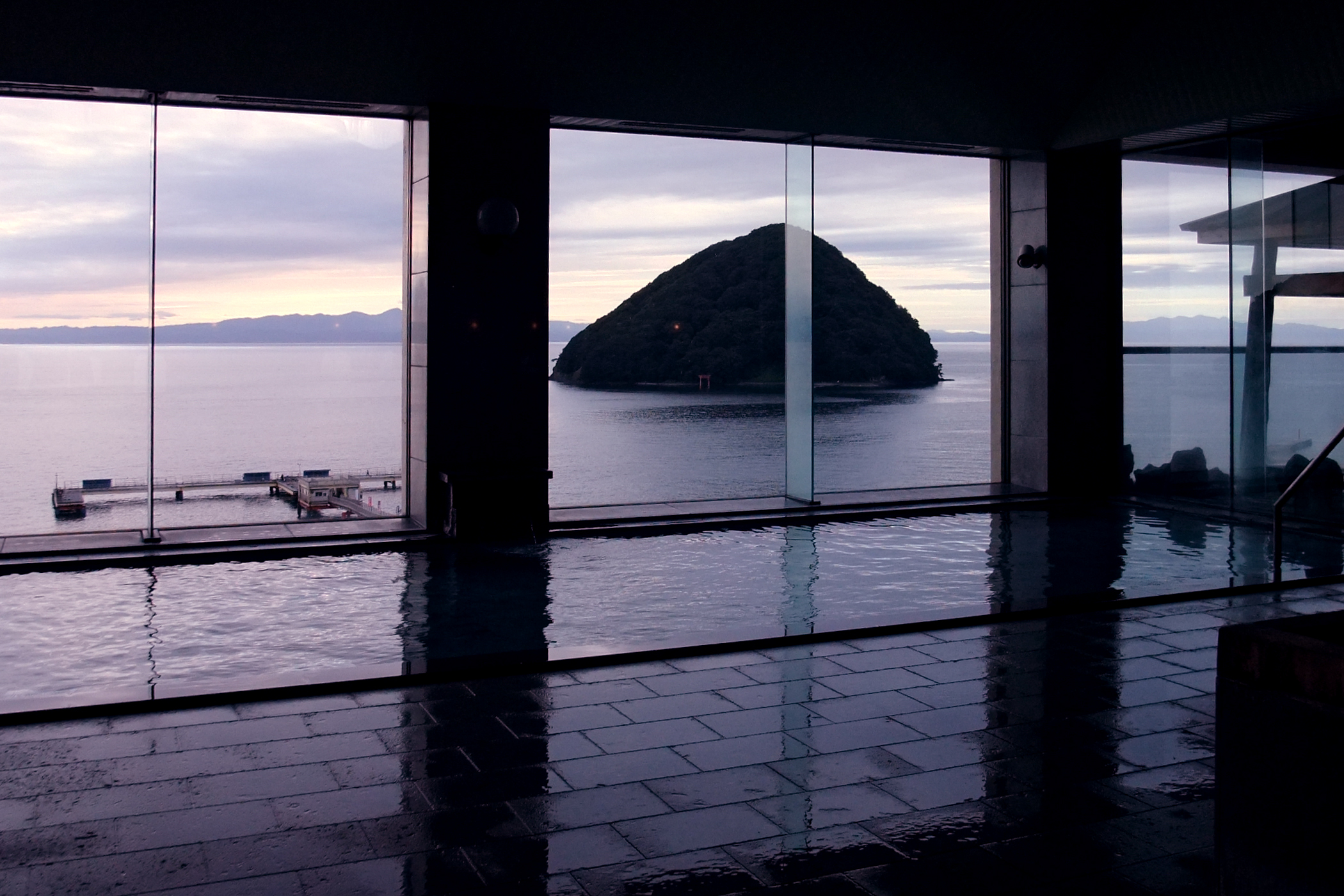|
Tokyo Story
is a 1953 Japanese drama film directed by Yasujirō Ozu and starring Chishū Ryū and Chieko Higashiyama, about an aging couple who travel to Tokyo to visit their grown children. Upon release, it did not immediately gain international recognition and was considered "too Japanese" to be marketable by Japanese film exporters. It was screened in 1957 in London, where it won the inaugural Sutherland Trophy the following year, and received praise from U.S. film critics after a 1972 screening in New York City. ''Tokyo Story'' is widely regarded as Ozu's masterpiece and one of the greatest films in the history of cinema. It was voted the greatest film of all time in the 2012 edition of a poll of film directors by '' Sight and Sound'' magazine. Plot summary Retired couple Shūkichi and Tomi Hirayama live in Onomichi in western Japan with their daughter Kyōko, a primary school teacher. They have five adult children, four of whom are living. The couple travel to Tokyo to visit t ... [...More Info...] [...Related Items...] OR: [Wikipedia] [Google] [Baidu] [Amazon] |
Yasujirō Ozu
was a Japanese filmmaker. He began his career during the era of silent films, and his last films were made in colour in the early 1960s. Ozu first made a number of short comedies, before turning to more serious themes in the 1930s. The most prominent themes of Ozu's work are family and marriage, and especially the relationships between generations. His most widely beloved films include ''Late Spring'' (1949), ''Tokyo Story'' (1953) and ''An Autumn Afternoon'' (1962). Widely regarded as one of the world's greatest and most influential filmmakers, Ozu's work has continued to receive acclaim since his death. In the 2012 ''Sight & Sound'' poll, Ozu's ''Tokyo Story'' was voted the third-greatest film of all time by critics world-wide. In the same poll, ''Tokyo Story'' was voted the greatest film of all time by 358 directors and film-makers world-wide. Biography Early life Ozu was born in the Fukagawa, Tokyo, Fukagawa district of Tokyo City, Tokyo, the second son of merchant Torano ... [...More Info...] [...Related Items...] OR: [Wikipedia] [Google] [Baidu] [Amazon] |
List Of Films Considered The Best
This is a list of films voted the best in national and international Opinion poll, surveys of Film criticism, critics and the public. Some surveys focus on all films, while others focus on a particular genre or country. Electoral system, Voting systems differ, and some surveys suffer from biases such as Self-selection bias, self-selection or skewed Demography, demographics, while others may be susceptible to forms of interference such as vote stacking. Critics and filmmakers ''Sight and Sound'' Every decade, starting in 1952, the British film magazine ''Sight and Sound'' asks an international group of film critics to vote for the greatest film of all time. Since 1992, they have invited directors to vote in a separate poll. Sixty-three critics participated in 1952, 70 critics in 1962, 89 critics in 1972, 122 critics in 1982, 132 critics and 101 directors in 1992, 145 critics and 108 directors in 2002, 846 critics and 358 directors in 2012, and 1639 critics and 480 direct ... [...More Info...] [...Related Items...] OR: [Wikipedia] [Google] [Baidu] [Amazon] |
David Bordwell
David Jay Bordwell (; July 23, 1947 – February 29, 2024) was an American film theorist and film historian. After receiving his PhD from the University of Iowa in 1973, he wrote more than fifteen volumes on the subject of cinema including ''Narration in the Fiction Film'' (1985), ''Ozu and the Poetics of Cinema'' (1988), ''Making Meaning'' (1989), and ''On the History of Film Style'' (1997). With his wife Kristin Thompson, Bordwell wrote the textbooks ''Film Art'' (1979) and ''Film History'' (1994). ''Film Art'', in its 12th edition as of 2019, is still used as a text in introductory film courses. With aesthetics philosopher Noël Carroll, Bordwell edited the anthology ''Post-Theory: Reconstructing Film Studies'' (1996), a polemic on the state of contemporary film theory. His largest work was ''The Classical Hollywood Cinema: Film Style and Mode of Production to 1960'' (1985), written in collaboration with Thompson and Janet Staiger. Several of his more influential articles on ... [...More Info...] [...Related Items...] OR: [Wikipedia] [Google] [Baidu] [Amazon] |
Depression-era
The Great Depression was a severe global economic downturn from 1929 to 1939. The period was characterized by high rates of unemployment and poverty, drastic reductions in industrial production and international trade, and widespread bank and business failures around the world. The economic contagion began in 1929 in the United States, the largest economy in the world, with the devastating Wall Street stock market crash of October 1929 often considered the beginning of the Depression. Among the countries with the most unemployed were the U.S., the United Kingdom, and Weimar Republic, Germany. The Depression was preceded by a period of industrial growth and social development known as the "Roaring Twenties". Much of the profit generated by the boom was invested in speculation, such as on the stock market, contributing to growing Wealth inequality in the United States, wealth inequality. Banks were subject to laissez-faire, minimal regulation, resulting in loose lending and wides ... [...More Info...] [...Related Items...] OR: [Wikipedia] [Google] [Baidu] [Amazon] |
Make Way For Tomorrow
''Make Way for Tomorrow'' is a 1937 American tragedy film directed by Leo McCarey. The plot concerns an elderly couple (played by Victor Moore and Beulah Bondi) who are forced to separate when they lose their house and none of their five children will take both parents. The film was written by Viña Delmar, from a play by Helen and Noah Leary, which was in turn based on the novel ''The Years Are So Long'' by advice columnist Josephine Lawrence. McCarey viewed the film as his best, and it has been praised by later critics. In 2010, it was selected for preservation by the United States Library of Congress's National Film Registry. Plot Barkley "Bark" ( Victor Moore) and Lucy Cooper ( Beulah Bondi) are an elderly couple who lose their home to foreclosure, as Barkley has been unable to find employment because of his age. They summon four of their five children—the fifth lives thousands of miles away in California—to break the news and decide where they will live until th ... [...More Info...] [...Related Items...] OR: [Wikipedia] [Google] [Baidu] [Amazon] |
Setsuko Hara And Yasujiro Ozu In Tokyo Story
Setsuko (written: or in hiragana) is a feminine Japanese given name. Notable people with the name include: *, later of Japan *, actress *, Japanese volleyball player *, Japanese actress and model * Setsuko Klossowska de Rola (born 1942), Japanese painter * Setsuko Kobori Japanese table tennis player *Koizumi Setsuko (小泉節子, 1868-1932), wife of Lafcadio Hearn *Setsuko Matsunaga Nishi (1921–2012), Japanese pioneering community activist and researcher *, Japanese yōga painter *, Japanese volleyball player *, Japanese swimmer *, Japanese novelist *, Japanese–Canadian nuclear disarmament campaigner *, Japanese novelist *, Japanese volleyball player Fictional characters *Setsuko, a character in the film ''Grave of the Fireflies'' *Setsuko Ohara, a character in the game ''Super Robot Wars Z This list provides an index of video game titles in Banpresto's ''Super Robot Wars'' franchise, known as ''Super Robot Taisen'' in Japan. Most of the games in the series are tactica ... [...More Info...] [...Related Items...] OR: [Wikipedia] [Google] [Baidu] [Amazon] |
Mutsuko Sakura
was a Japanese actress. Her hobby was golf. She started work at Shochiku in 1950, and played supporting roles in some of Yasujirō Ozu's films. She was a constant in Japanese film and TV drama for half of the 20th century. Selected filmography Film * (1950) * (1950) - Oroku * (1950) * (1950) * (1950) * (1951) - Kaoko Fukuda, Namiko's sister * '' Boyhood'' (1951) - Mrs. Yamazaki * (1951) - Tomie Honda * (1951) * (1952) - Mitsuyo * (1952) - Oryû * (1953) * ''Tokyo Story'' (1953) - Oden-ya no onna * (1953) - Osugi Morikawa * (1954) - Madame at bar * (1954) * (1955) - Hama Katagiri * (1955) * (1955) - Otsuko, second daughter * (1956) * (1956, part 1, 2) - Reiko * (1956) - Omutsu * (1956) - Sushi shop lady * (1956) * '' Tokyo Twilight'' (1957) * '' Times of Joy and Sorrow'' (1957) * (1957) * (1958) * (1958) * (1958-1959, part 1, 2) * '' Equinox Flower'' (1958) - Akemi * (1959) - Kikutarô * ''Good Morning'' (1959) - Oden'ya no Nyôbô * ''High Teen'' (1 ... [...More Info...] [...Related Items...] OR: [Wikipedia] [Google] [Baidu] [Amazon] |
So Yamamura 3
SO or so may refer to: Arts and entertainment Music * ''So'' (album), an album by Peter Gabriel * So (band), a duo from the 1980s formed by two members of The Opposition * "So" (Static-X song), a song by Static-X * "Sō (New Love New World)", a song by Masaharu Fukuyama * "So", a song by War from '' Why Can't We Be Friends?'' * "So", a song by Fates Warning from '' Disconnected'' * S.O. (rapper) Other * "SO" (''Sons of Anarchy''), the third season premiere of the FX television series ''Sons of Anarchy'' * So Television, a British TV production company Relationships * Significant other, a partner in an intimate relationship Businesses * Austrian Air Services (former IATA airline designator SO) * Sosoliso Airlines (former IATA airline designator SO) * Southern Airways (former IATA airline designator SO) * Southern Company (stock symbol SO) * Superior Aviation (IATA airline designator SO) Language * So language (Democratic Republic of Congo), a Bantu language * Sô langua ... [...More Info...] [...Related Items...] OR: [Wikipedia] [Google] [Baidu] [Amazon] |
Osaka
is a Cities designated by government ordinance of Japan, designated city in the Kansai region of Honshu in Japan. It is the capital of and most populous city in Osaka Prefecture, and the List of cities in Japan, third-most populous city in Japan, following the special wards of Tokyo and Yokohama. With a population of 2.7 million in the 2020 census, it is also the largest component of the Keihanshin, Keihanshin Metropolitan Area, which is the List of metropolitan areas in Japan, second-largest metropolitan area in Japan and the 10th-List of urban areas by population, largest urban area in the world with more than 19 million inhabitants. Ōsaka was traditionally considered Japan's economic hub. By the Kofun period (300–538) it had developed into an important regional port, and in the 7th and 8th centuries, it served briefly as the imperial capital. Osaka continued to flourish during the Edo period (1603–1867) and became known as a center of Japanese culture. Following the M ... [...More Info...] [...Related Items...] OR: [Wikipedia] [Google] [Baidu] [Amazon] |
Ueno Park
is a spacious public park in the Ueno, Tokyo, Ueno district of Taitō, Tokyo, Japan. The park was established in 1873 on lands formerly belonging to the Buddhist temples in Japan, temple of Kan'ei-ji. Amongst the country's first public parks, it was founded following the Park#History, Western example as part of the borrowing and assimilation of international practices that characterizes the early Meiji period. The home of a number of major museums, Ueno Park is also celebrated in spring for its cherry blossoms and ''hanami''. In recent times the park and its attractions have drawn over ten million visitors a year, making it Japan's most popular city park. History Ueno Park occupies land once belonging to Kan'ei-ji, founded in 1625 in the "Oni (folklore)#Demon Gate, demon gate", the Feng shui, unlucky direction to the northeast of Edo Castle. Most of the temple buildings were destroyed in the Battle of Ueno in 1868 during the Boshin War, when the forces of the Tokugawa shogunate ... [...More Info...] [...Related Items...] OR: [Wikipedia] [Google] [Baidu] [Amazon] |
Atami
is a city located in Shizuoka Prefecture, Japan. , the city had an estimated population of 36,865 in 21,593 householdsAtami City official statistics and a of 600 persons per km2. The total area of the city is . Geography Atami is located in the far eastern corner of at the northern end of . The city is on the steep slopes of a partial ...[...More Info...] [...Related Items...] OR: [Wikipedia] [Google] [Baidu] [Amazon] |
Onsen
In Japan, are hot springs and the bathing facilities and Ryokan (inn), traditional inns around them. There are approximately 25,000 hot spring sources throughout Japan, and approximately 3,000 ''onsen'' establishments use naturally hot water from these Geothermal gradient, geothermally heated springs. ''Onsen'' may be either or . Traditionally, ''onsen'' were located outdoors, although many inns have now built indoor bathing facilities as well. Nowadays, as most households have their baths, the number of traditional public baths has decreased, but the number and popularity of have increased since the end of World War II, Second World War. Baths may be either publicly run by a municipality or privately, often connecting to a lodging establishment such as a hotel, ''Ryokan (inn), ryokan'', or ''Ryokan (inn)#Minshuku, minshuku''. The presence of an ''onsen'' is often indicated on signs and maps by the symbol ♨, the kanji (''yu'', meaning "hot water"), or the simpler phonet ... [...More Info...] [...Related Items...] OR: [Wikipedia] [Google] [Baidu] [Amazon] |





